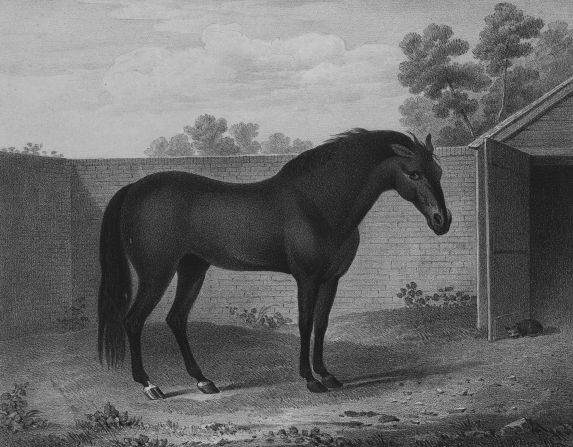
A history of the thoroughbred —
Every thoroughbred horse can be traced back to one of three stallions, and 95% of those go back to one -- the Godolphin Arabian, pictured. Named after his owner, Earl Francis Godolphin, the stallion lived from 1724-1753 and sired some of the greatest racehorses in history, with Seabiscuit and Man o' War just two of his direct descendants.

The first great racehorse —
Sired by the Darley Arabian --one third of the thoroughbred stallion trifecta, along with the Godolphin Arabian and the Byerly Turk -- Flying Childers is often credited as the first true "great racehorse."He was retired to stud after winning all six of his races in the early 18th century. His British owner, the Duke of Devonshire, once reportedly received an offer to buy the stallion for the price of its weight in gold.

The greatest racehorse of all time —
Grand foal of the Godolphin Arabian, Eclipse is perhaps the greatest thoroughbred ever to race. After 18 wins from 18 starts in only 17 months, Eclipse was retired to stud in 1771 due to lack of competition, as nobody would bet on the other horses. The Eclipse Stakes at England's Sandown Park are a testament to his legacy.

It's all in the name —
Potoooooooo (often spelled "Pot-8-Os") is responsible for a key element of horseracing -- that of abstract and often ludicrous naming. Sired by the great Eclipse, he was originally to be "Potatoes" but after a stableboy misspelled his name on a feedbin the horse's breeder -- the 4th Earl of Abingdon -- found the mistake so humorous he decided to keep it that way.

The Aleppo connection —
In 1878 Wilfrid Scawen Blunt, pictured, and his wife Lady Anne Blunt established what would become Britain's foremost thoroughbred stud farm. Crabbet Arabian Stud was founded after the Blunts decided -- while on holiday in Syria -- to bring back some of the best Arabian horses for breeding in England. Now, 90% of all Arabian horses can be traced back to Crabbet.

Horses on film —
Persimmon, depicted here with his owner King Edward VI, is the first horse to be captured on film. The 1895 filming of the Epsom Derby fast became a worldwide cultural phenomenon, with thousands of people flocking to exhibitions to witness racing on film for the first time. Persimmon accumulated what would be $3.5 million in on-track prize money by modern standards.

The greatest horse since Eclipse —
American horse Man o' War won 20 of 21 races he started, raking in more than $7.5 million in today's equivalent prize money. For six races as a two-year-old, his handicap of 130 pounds was one of the heaviest ever carried.

The next generation —
Black Caviar, pictured, is the most successful sprinter in the world with a unbeaten record of 25 wins.


